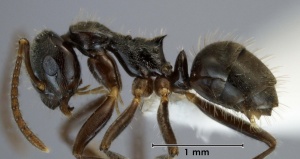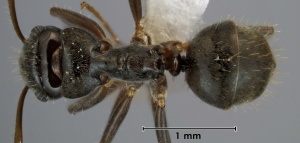Teratomyrmex
| Teratomyrmex | |
|---|---|

| |
| Teratomyrmex greavesi | |
| Scientific classification | |
| Kingdom: | Animalia |
| Phylum: | Arthropoda |
| Class: | Insecta |
| Order: | Hymenoptera |
| Family: | Formicidae |
| Subfamily: | Formicinae |
| Tribe: | Melophorini |
| Genus: | Teratomyrmex McAreavey, 1957 |
| Type species | |
| Teratomyrmex greavesi | |
| Diversity | |
| 3 species (Species Checklist, Species by Country) | |
Teratomyrmex is rarely encountered and fewer than 30 collections are present in ANIC. The majority come from rainforests, except one which is from a dry sclerophyll forest on Mt. Coot-tha, Brisbane. Teratomyrmex greavesi can be locally common but the other two known species are rarely found and then only as stray foragers. They may nest in rotten wood on the ground. Very little is known of their biology. (Shattuck and Reilly 2013)
Identification
The propodeum has a single pair of spines. The pronotum is expanded towards the sides into wing-like projections.
Shattuck and Reilly (2013) - The genus has been characterised by the distinct wing-like projections on the pronotum which were described (Wheeler and Wheeler 1974, Teratomyrmex greavesi) ‘as if it has a huge tumor on the top of its thorax’. However, two more recently found species have these pronotal projections less well developed, although still present.
| See images of species within this genus |
Keys including this Genus
Keys to Species in this Genus
Distribution
Distribution and Richness based on AntMaps
Species by Region
Number of species within biogeographic regions, along with the total number of species for each region.
| Afrotropical Region | Australasian Region | Indo-Australian Region | Malagasy Region | Nearctic Region | Neotropical Region | Oriental Region | Palaearctic Region | |
|---|---|---|---|---|---|---|---|---|
| Species | 0 | 3 | 0 | 0 | 0 | 0 | 0 | 0 |
| Total Species | 2840 | 1735 | 3042 | 932 | 835 | 4378 | 1740 | 2862 |
Biology
Life History Traits
- Mean colony size: ? (Greer et al., 2021)
- Compound colony type: not parasitic (Greer et al., 2021)
- Nest site: hypogaeic (Greer et al., 2021)
- Diet class: ? (Greer et al., 2021)
- Foraging stratum: subterranean/leaf litter; arboreal (Greer et al., 2021)
Castes
Worker of T. greavesi from Queensland.
Morphology
Worker Morphology
 Explore: Show all Worker Morphology data or Search these data. See also a list of all data tables or learn how data is managed.
Explore: Show all Worker Morphology data or Search these data. See also a list of all data tables or learn how data is managed.
• Antennal segment count: 12 • Antennal club: gradual • Palp formula: 6,4 • Spur formula: 1 simple, 1 simple • Eyes: >100 ommatidia • Pronotal Spines: absent • Mesonotal Spines: absent • Propodeal Spines: present • Petiolar Spines: absent • Caste: none or weak • Sting: absent • Metaplural Gland: present • Cocoon: present
Male Morphology
 Explore: Show all Male Morphology data or Search these data. See also a list of all data tables or learn how data is managed.
Explore: Show all Male Morphology data or Search these data. See also a list of all data tables or learn how data is managed.
• Caste unknown
Phylogeny
| Formicinae |
| |||||||||||||||||||||||||||||||||||||||||||||||||||||||||||||||||||||||||||||||||||||||||||||||||||||||||||||||||||||||||||||||||||||||||||||||||||||||||||||||||||||||||||||||||||||||||||||||||||||||||||||||||||||||||||||||||||||||||||||||||||||||||||||||||||||||||||||||||
See Phylogeny of Formicinae for details.
Nomenclature
The following information is derived from Barry Bolton's Online Catalogue of the Ants of the World.
- TERATOMYRMEX [Formicinae: Lasiini]
- Teratomyrmex McAreavey, 1957: 54. Type-species: Teratomyrmex greavesi, by original designation.
Unless otherwise noted the text for the remainder of this section is reported from the publication that includes the original description.
Worker. Monomorphic.
Head almost square with broad triangular mandibles furnished with five small sharp teeth. Maxillary palpi with four slender, equal segments. Labial palpi with two slender, equal segments. Clypeus rather large, anterior border entire, posterior border rounded and not extending back between the frontal carinae. Frontal area sub triangular, distinct. Frontal carinae, short and stralght. Antennal and clypeal fossae not confluent, but antennae placed close to the clypeus. Antennae twelve segmented, funiculus filiform, with first segment as long as two following, remaining segments longer than broad, apical longer than preceding segment. Eyes moderately large, convex. Ocelli distinct.
Thorax of most unusual shape. Dorsum of pronotum very flattened, margined. This flattened surface is about three times as broad as long, the anterior and posterior borders deeply concave, the sides strongly convex, the corners rounded. The sides of the pronotum slope inwards and can be seen only in the profile view. The mesonotum resembles a cylinder which fits under the posterior raised lip of the pronotum, and is about a third as broad as the pronotum. Metanotum slightly broader than mesonotum and surmounted by two distinct spiracular tubercles. The dorsum of epinotum resembles a wide-necked flask, the anterior half circular, the posterior half is narrowed, with parallel sides, the posterior corners produced as broad sharp teeth. The posterior border, between these teeth deeply concave. Petiole surmounted by an erect scale-like node which is greatly narrowed at the top. It bears no spines. Gaster not overhanging petiole, ovate, with the cloacal orifice surrounded by a fringe of hairs. Legs moderately long, middle and hind tibiae with pectinate spurs, tarsal claws simple.
Etymology
McAreavey gave the genus the name Teratomyrmex after the latin ‘terato’, meaning monster, wonder, or marvel. (Shattuck and Reilly 2013)
References
- Agosti, D. 1991. Revision of the oriental ant genus Cladomyrma, with an outline of the higher classification of the Formicinae (Hymenoptera: Formicidae). Syst. Entomol. 16: 293-310. (page 295, Teratomyrmex in Formicinae, Formica genus group)
- Bolton, B. 1994. Identification guide to the ant genera of the world. Cambridge, Mass.: Harvard University Press, 222 pp. (page 50, Teratomyrmex in Formicinae, Lasiini)
- Bolton, B. 2003. Synopsis and Classification of Formicidae. Mem. Am. Entomol. Inst. 71: 370pp (page 100, Teratomyrmex in Formicinae, Lasiini)
- Boudinot, B.E., Borowiec, M.L., Prebus, M.M. 2022. Phylogeny, evolution, and classification of the ant genus Lasius, the tribe Lasiini and the subfamily Formicinae (Hymenoptera: Formicidae). Systematic Entomology 47, 113-151 (doi:10.1111/syen.12522).
- Cantone S. 2018. Winged Ants, The queen. Dichotomous key to genera of winged female ants in the World. The Wings of Ants: morphological and systematic relationships (self-published).
- Dlussky, G. M.; Fedoseeva, E. B. 1988. Origin and early stages of evolution in ants. Pp. 70-144 in: Ponomarenko, A. G. (ed.) Cretaceous biocenotic crisis and insect evolution. Moskva: Nauka, 232 pp. (page 77, Teratomyrmex incertae sedis in Formicinae)
- McAreavey, J. 1957. Revision of the genus Stigmacros Forel. Mem. Natl. Mus. Vic. 21: 7-64 (page 54, Teratomyrmex in Formicinae, Lasiini)
- Shattuck, S.O. & O'Reilly, A.J. 2013. Revision of the Australian endemic ant genera Pseudonotoncus and Teratomyrmex (Hymenoptera: Formicidae: Formicinae). Zootaxa 3669, 287–301.
- Wheeler, G. C.; Wheeler, J. 1985b. A simplified conspectus of the Formicidae. Trans. Am. Entomol. Soc. 111: 255-264 (page 258, Teratomyrmex in Formicinae, Formicini)




